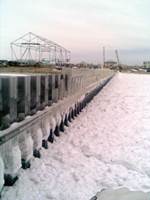Polyurethane pultrusion: Next-gen equipment
Two years ago, Martin Pultrusion Group (MPG, Oakwood Village, Ohio) finalized the design of a next-generation pultrusion machine and has developed a proprietary direct injection box design for high-pressure pultrusion of polyurethane composites.
According to Jeff Martin, CEO of Martin Pultrusion Group (MPG, Oakwood Village, Ohio), pultrusion with polyurethanes (PU) — with some initial equipment investment and processing tweaks — can be done on existing pultrusion equipment. Each die requires a machined injection box (for high-volume applications that incorporate dense layers of rovings and biaxial or triaxial fabrics). These are typically manufactured from aluminum or stainless steel, at an investment cost that can range, says Martin, “from a few thousand dollars to perhaps as much as $20,000 as dictated by the size and complexity of the profile being processed.” Also, a meter/mix system is required to pump the material into the injection box. Martin estimates that this piece of equipment, with a static mixer on the end, can cost between $25,000 and $40,000 for each processing cavity. There are also steps that must be taken to address PU’s high processing heat, low shrinkage and increased pull force.
MPG, however, is all-in when it comes to PU pultrusion. Two years ago the company finalized the design of a next-generation pultrusion machine and has developed a proprietary direct injection box design for high-pressure pultrusion. The tools represented a major investment in PU.
One of the primary differences in its next-generation machine design is the overall robustness of the system. PU pultrusion can require stiffer frames and more powerful hydraulics to handle the larger profiles. Also, due to the high glass loading and stiffness of the urethane resin, PU lines can experience significantly higher pulling forces.
“Our polyester machines typically had approximately 6 tons of pulling force,” explains Martin. “The minimum we have run in urethane is 12 tons. We primarily focus on polyurethane applications that require a 20-ton pull force,” he says, noting that one upcoming order will require a 40-ton pull force.
Today MPG provides pultrusion services and markets equipment to other pultruders. For the latter, the next-gen machinery is not just an option, it’s the only option. “Even if our customers want a polyester machine,” says Martin, “we are selling the upgraded machine because we believe that those who are using polyester today will find themselves wanting to have hardware to run urethane in the future.”
Martin is equally optimistic about the future of his direct injection system, particularly in light of potential action by the U.S. Environmental Protection Agency (Washington. D.C.). “The EPA is starting to become very critical of our industry because of the VOCs associated with traditional, open bath processing,” he points out. “Moving to a closed bath, contained injection system significantly reduces emission issues surrounding VOCs, including employee exposure.” Further, the pure PU resin system now used by Gulf Synthetics (Cummings, Ga.) — Baydur PUL 2500, supplied by Bayer MaterialScience (Pittsburgh, Pa.) — features 10 percent bio-content. According to Bayer’s new markets manager, Harry George, a new formulation (Baydur PUL 3500) will feature 20 percent bio-content.
Related Content
-
Hexagon Purus Westminster: Experience, growth, new developments in hydrogen storage
Hexagon Purus scales production of Type 4 composite tanks, discusses growth, recyclability, sensors and carbon fiber supply and sustainability.
-
Bio-based acrylonitrile for carbon fiber manufacture
The quest for a sustainable source of acrylonitrile for carbon fiber manufacture has made the leap from the lab to the market.
-
Recycling end-of-life composite parts: New methods, markets
From infrastructure solutions to consumer products, Polish recycler Anmet and Netherlands-based researchers are developing new methods for repurposing wind turbine blades and other composite parts.















